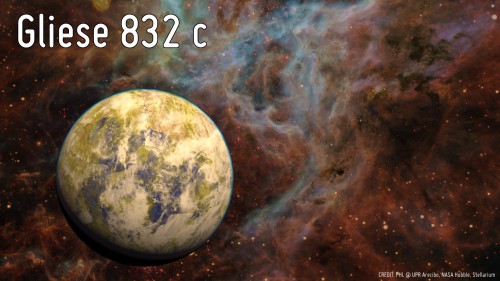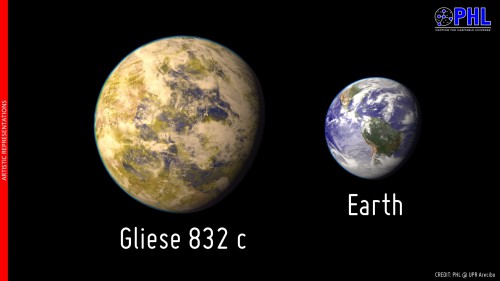
As the number of exoplanets discovered continues to grow exponentially, the number of potentially habitable worlds out there continues to increase as well. Astronomers have now reported finding another one of the nearest known of these kinds of planets so far, Gliese 832c.
Gliese 832c is a super-Earth orbiting the red dwarf star Gliese 832, which is only 16 light-years away—very close in terms of cosmic distances. The discovery was made by an international team of astronomers, led by led by Robert A. Wittenmyer from UNSW Australia. The planet orbits close to its star in only 36 days, but because of the less energy output from the star, which is smaller than our Sun, it receives about the same amount of solar energy as Earth does, instead of broiling like Mercury. Gliese 832 c has a mass at least five times that of Earth, making it a “super-Earth” type of exoplanet: solid and rocky, but larger than Earth, while still being smaller than gas or ice giant planets.
While the actual surface conditions are not yet known, Gliese 832c could have Earth-like temperatures, depending on what kind of atmosphere it has. If the atmosphere is anything like ours, then it may have conditions suitable for some form of life. If, however, it has a denser atmosphere, then there is the possibility of an extreme greenhouse effect, which would make this a world more similar to Venus than Earth, a kind of “super-Venus.” Even if the atmosphere is more Earth-like, the planet would likely experience extreme seasonal shifts. Until more is known about its composition and atmosphere, these are the best estimates that astronomers have.

The Gliese 832 system is known to also have at least one Jupiter-like planet orbiting farther out, Gliese 832b, which was discovered in 2009. It’s a kind of scaled-down version of our own solar system, but with only two known planets so far.
Gliese 832c has just been added to the Habitable Exoplanets Catalog, which as of now has a listing of 23 potentially habitable exoplanets. These planets are ranked according to the Earth Similarity Index (ESI), which measures their similarity to Earth based on known factors. An exact “twin” of Earth would be 1.0 on the scale. Gliese 832c is ranked as 0.81, one of the highest so far. For comparison, two other planets in the catalog, Gliese 667Cc and Kepler-62e, are listed with an ESI of 0.84 and 0.83 respectively.
The announcement comes soon after the previously reported discovery of the potentially habitable exoplanet Kapteyn b, one of two known super-Earth planets orbiting the star Kapteyn’s Star, another red dwarf approximately 12.7 light-years away. Kapteyn b’s ESI is listed as 0.68.
With the findings from missions such as the Kepler space telescope and other ground-based observatories that smaller rocky worlds like Earth or even super-Earths are common in the galaxy, the chances for evidence of alien life eventually being found have greatly increased in recent years. Learning more about planets like Gliese 832c make this an exciting time of discovery.
The published paper is available here.
Want to keep up-to-date with all things space? Be sure to “Like” AmericaSpace on Facebook and follow us on Twitter:@AmericaSpace




At best, the claim by the Planetary Habitability Laboratory that GJ 832c is one of the most Earth-like planets found to date is overly optimistic. Robert Wittenmyer and his team clearly state in their discovery paper that GJ 832c is more likely to be a super-Venus than a habitable super-Earth. The fact that GJ 832c was found using precision Doppler measurements also means that we only know this planet’s minimum mass. In fact, the odds are in favor of this newly discovered world *NOT* being even a terrestrial planet never mind a habitable one. The following essay discusses these issue in detail:
http://www.drewexmachina.com/2014/06/27/gj-832c-habitable-super-earth-or-super-venus/